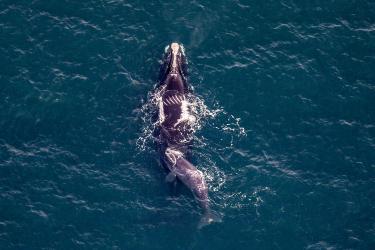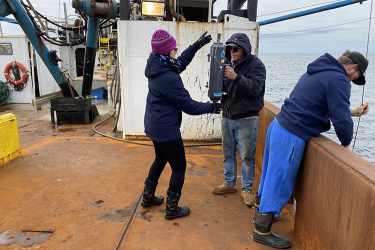A unique opportunity that’s offered for teachers to participate in the NOAA surveys is the Teacher At Sea (TAS) program. It gives teachers from all 50 states, Puerto Rico, Guam and American Samoa the opportunity to participate on our surveys. This leg, we were fortunate to have Thomas Jenkins from Ohio sail with us on the Bigelow during the spring bottom trawl survey.
With his positive attitude, creativity and excitement to learn, he was the perfect fit! Aside from teaching 8th grade engineering and general science, he is the science laureate at Teaching Channel, an online community for teachers made up of teachers who provide videos to improve teaching practices, share references and create relevant content to keep up with changes in science, technology and engineering. As science and engineering standards are increasing, Tom stays ahead of the game by participating in opportunities that give him first hand experiences that he can bring back to his students.
With not knowing exactly what to expect on a bottom trawl survey, Tom was greatly appreciative of everyone’s openness and eagerness to show and teach him everything. For the most part, he thought the survey would mostly be recording length, weight and sex of the fish. It was a surprise to find out how in depth the sampling was and how much more work needed to be done after the survey ends. Most of the information and samples collected undergo further processing and analysis back at the NEFSC labs while other samples were requested from people working on research projects at outside labs or universities. His excitement to learn was matched by the excitement of the scientific crew to teach. “If you see something, say something.” That is always told to everyone sailing. Either during work-ups or after, everyone was always willing to answer questions and give explanations to any questions.
Tom compared experiencing this survey to feeling like a 7-year-old and seeing everything for the first time. It’s no picnic living in a marine environment, and to successfully thrive in this mysterious ecosystem, the adaptations marine organisms evolved are “so different and cool!” “The diversity was amazing!”
In particular, he was fascinated with the monkfish. It uses its illicium, a modified dorsal ray, to lore prey to its giant mouth and move it to its stomach using the many sharp teeth in the front and back of the mouth, like a conveyer belt. Another animal that sparked Tom’s interest was the longhorn sculpin with its head covered with many sharp spines and the vibrating hum it makes when agitated. Toward the end of the trip, we started catching lobster, and Tom was excited to hold a lobster whose one claw was the size of his hand!
His students are a clear passion! In-between tows and after shifts, Tom could be found working on his blogs and collecting information and video capturing different phenomena, such as counter shading, eating habits, pressure changes, and defense mechanisms, to name a few. He was constantly brainstorming ideas for interactive lesson plans that explain those phenomena. For example, he mentioned a lesson that would have his students engineer different types of mouths and try to pick up various objects as a way to understand that examining a fish’s mouth is a great way to get an instant idea of their diet.
His students didn’t have to wait for Tom to be back in the classroom to be a part of this journey. He used social media, Facebook, Instagram and Twitter to communicate informally with his 120 following students! As he posted daily pictures and updates, they asked him questions and received a quick reply. And the fun will continue when he returns to his classroom.
After 3 weeks of being away from family and friends, Tom was ready to go back and share everything he learned! And with all his video footage, he’ll have plenty of work to keep him busy for a while.
The Teacher At Sea program is a great way to establish networks and opportunities between Tom, his current and future students, the Teaching Channel community, and the crew and scientists on the ship. It’s always important to encourage and empower a strong scientific community.
Overall, Tom would definitely come back if the opportunity presented itself! “Meeting people who are excited about what they do and who they work with, and learning something new re-energizes me, and makes me want to share the information.”
Christine Kircun
Aboard the Henry B. Bigelow
SBTS HB18-02 Leg 3



